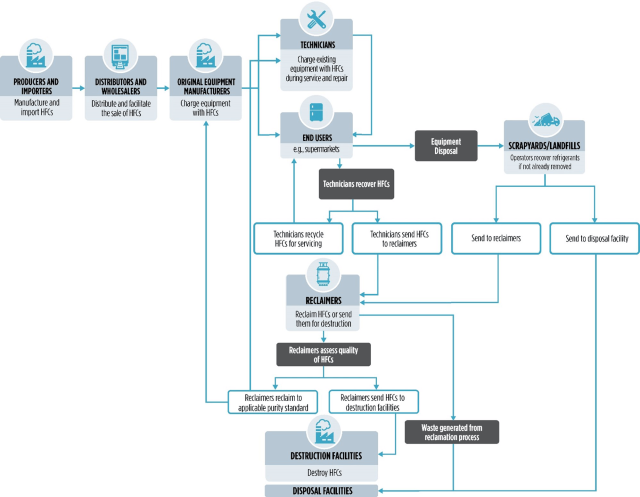Background on HFC Reclamation and Destruction
In the United States, HFCs are primarily used in equipment in the refrigeration, air conditioning, and heat pump (RACHP) sector. These RACHP appliances are used in homes, commercial buildings, industrial operations, refrigerated transport, motor vehicle air conditioning, and more. Approximately 75% of total HFC use occurs in refrigeration and air conditioning equipment in homes, commercial buildings, and industrial operations. The figure below provides the estimated breakdown of HFCs used as refrigerants, in metric tons, contained in various types of installed appliances in the RACHP sector expected in 2025. Unitary air conditioning (AC) and heat pumps (HP) are anticipated to have the greatest volume of HFCs in installed appliances in 2025. This includes appliances such as residential air conditioning systems.
Destroying unwanted HFCs helps prevent climate-damaging emissions because HFCs that are destroyed cannot be vented or released to the atmosphere. Reclaiming used HFCs helps reduce the need to produce new HFCs and helps support the EPA's efforts to phase down production of HFCs. For additional information on the HFC phasedown, see Protecting Our Climate by Reducing the Use of HFCs.
The public is expected to reap climate benefits from transitioning away from using climate-damaging HFCs. While HFC reclamation and destruction may have broader benefits for the climate, and HFCs are not known to harm human health, the increased reclamation and destruction of these chemicals could have unintended negative impacts on communities near reclamation or destruction facilities.
The following diagram below illustrates the general flow of HFCs through each of the key stakeholders, including producers and importers, wholesalers (including distributors), technicians, end users, reclaimers, destruction facilities, scrap recyclers, and landfills. In general, technicians recover HFCs and either send them for reclamation or send them for destruction. Depending on the quality of the recovered refrigerant, reclaimers decide whether to reclaim the HFCs to the required purity standard or send them to destruction facilities. For example, reclaimers may choose to send recovered refrigerants for destruction if they are so contaminated as to make the reclamation process cost-prohibitive or infeasible from a technological standpoint.


